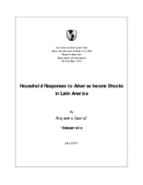Household Responses to Adverse Income Shocks in Latin America
Date
Jul 2001
This paper uses a new data set to study household responses to adverse income shocks in seven Latin American countries. The results show (i) that households respond to income shocks mainly by increasing their labor force participation, selling assets, and cutting back on human capital investments, (ii) that poor households are the most likely to be affected by adverse income shocks, and (iii) that lower-middle-class households are more likely to cut back on human capital investments and move abroad when faced with an adverse income shock. Taken together, these results offer ample justification for publicly funded safety nets that target the poor.



